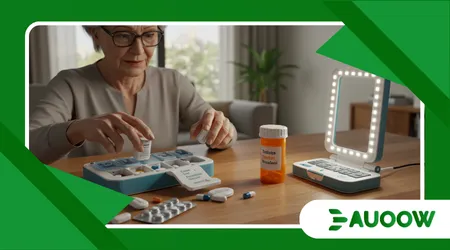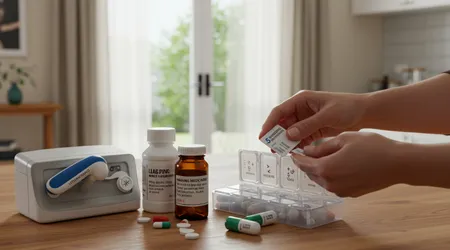Managing Medication with Low Vision: Helpful Tools

Managing medication with low vision can feel like navigating a maze in dim light, but innovative tools and strategies are transforming this challenge into an opportunity for empowerment.
For the 2.2 billion people worldwide with vision impairment, as reported by the World Health Organization in 2024, daily tasks like medication management require creative solutions.
This article dives into practical, cutting-edge tools designed to foster independence, boost confidence, and ensure safety for those with low vision.
From tactile aids to smart technology, we’ll explore how these innovations are reshaping lives, offering real-world examples and actionable insights.
Why settle for dependence when you can take control with the right support?
Living with low vision doesn’t mean surrendering autonomy. Tools tailored for accessibility are leveling the playing field, making medication management seamless and secure.
This guide, crafted for the Daily Accessibility blog, blends expert insights with real-life applications, ensuring you’re equipped to thrive.
Let’s uncover the solutions that make managing medication with low vision not just possible, but intuitive.
Understanding the Challenges of Low Vision in Medication Management
For individuals with low vision, identifying pills or reading labels is a hurdle. Small print and similar-looking medications heighten the risk of errors.
Imagine mistaking a painkiller for a heart medication consequences can be severe. Daily routines become daunting without clear visual cues.
The emotional toll is significant too. Frustration or anxiety from struggling with prescriptions can erode confidence.
Independence, a cornerstone of dignity, feels threatened when reliance on others grows. Tools must address both practical and emotional barriers.
Moreover, medication schedules are complex. Multiple doses, varying times, and specific instructions demand precision.
Low vision complicates tracking, increasing the chance of missed or incorrect doses. Accessible solutions are critical for safety.
++ How to Advocate for Better Accessibility in Your Neighborhood
The healthcare system often overlooks these needs. Standard pill bottles lack tactile or auditory features, leaving gaps in accessibility.
This underscores the urgency for specialized tools to bridge the divide.
Innovative aids are emerging to tackle these issues. From tactile markers to voice-activated devices, technology is evolving to meet diverse needs. These tools empower users to manage medications confidently.

Tactile Tools: Simplifying Identification Through Touch
Tactile aids transform managing medication with low vision by leveraging touch over sight.
Adhesive bump dots, for instance, can mark different pill bottles distinctly. A single dot might indicate morning meds, two for evening.
Rubber bands offer another simple solution. Wrapping a unique number of bands around each bottle creates an identifiable pattern. For example, Jane, a retiree with macular degeneration, uses this method flawlessly.
Tactile pill organizers elevate this approach. These containers feature raised numbers or Braille for each compartment. They’re intuitive, reducing guesswork in daily routines. Brands like MaxiAids offer durable options.
Also read: The Best Phones for Accessibility Features in 2025
Cost-effectiveness makes tactile tools appealing. Most are under $10, ensuring accessibility for all budgets. Their simplicity belies their profound impact on independence.
However, tactile aids require initial setup. Learning new systems may demand patience, but the payoff—self-reliance is worth it. Consistency in use is key to success.
Auditory Solutions: Harnessing Sound for Safety
Auditory tools bring managing medication with low vision into the realm of sound, offering clarity where vision falls short. Talking prescription labels are a game-changer. Devices like the ScriptTalk system read label details aloud.
Smart speakers, like Amazon Echo, can set medication reminders. “Alexa, remind me to take my insulin at 8 AM” ensures timely prompts. John, a veteran, relies on this daily.
Apps like Medisafe provide voice-guided instructions. These apps audibly confirm medication names and dosages, minimizing errors. They’re free or low-cost, broadening access.
Read more: How to Improve Accessibility in Rental Apartments
Auditory tools shine in their immediacy. Hearing instructions bypasses visual barriers, offering instant clarity. Integration with smartphones enhances their versatility.
Yet, background noise can interfere. Users must ensure quiet environments for clear audio. Battery life and device reliability also warrant attention for consistent use.
Auditory solutions aren’t one-size-fits-all. Some prefer simpler devices over complex apps. Exploring options ensures the best fit for individual needs.
Smart Technology: The Future of Medication Management
Smart devices are revolutionizing managing medication with low vision with cutting-edge innovation.
Smart pill dispensers, like Hero, automatically sort and dispense medications. They alert users via lights and sounds.
Wearable tech, such as smartwatches, offers vibrating reminders. These discreet prompts fit seamlessly into daily life. Maria, a teacher, swears by her Apple Watch for this.
AI-powered apps, like Seeing AI, scan and read labels aloud. These tools use smartphone cameras to describe medications, enhancing accessibility. They’re often free, too.
Smart technology offers precision and connectivity. Many devices sync with apps, allowing caregivers to monitor adherence remotely. This fosters both independence and support.
However, tech can be pricey. Smart dispensers often cost over $100, posing barriers for some. Learning curves may also challenge less tech-savvy users.
Reliability is crucial. Internet outages or device malfunctions can disrupt schedules. Backup plans, like tactile aids, ensure uninterrupted management.
Organizational Strategies: Streamlining the Process
Effective organization is vital for managing medication with low vision. Pill organizers with large, high-contrast compartments simplify sorting. They’re widely available and user-friendly.
Color-coded systems enhance accessibility. Brightly colored bottles or labels stand out, even for those with partial vision. Pharmacies often provide these upon request.
Partnering with pharmacists is a smart move. They can pre-sort medications into accessible formats, reducing errors. CVS and Walgreens offer such services.
Consistency in storage locations prevents confusion. Designating a specific spot for medications builds routine. For example, Tom keeps his on a labeled tray.
Weekly planning reduces daily stress. Setting up organizers once a week streamlines managing medication with low vision. It’s a small investment for big returns.
Involving family or caregivers can help. They can assist with setup while respecting autonomy. Clear communication ensures everyone understands the system.
Accessibility in Pharmacy Services: Bridging the Gap

Pharmacies are stepping up to support managing medication with low vision. Large-print labels are now standard at many chains, like Rite Aid. Request them explicitly.
Some pharmacies offer Braille labels. This service, though less common, is a lifeline for Braille users. Inquire about availability at local pharmacies.
Home delivery services, like PillPack, pre-package medications by dose. This eliminates sorting challenges, delivering pre-organized packets directly to users.
Pharmacists can provide verbal consultations. Discussing prescriptions in detail clarifies instructions. Recording these conversations aids memory for later reference.
Advocacy is key. Requesting accommodations ensures pharmacies prioritize accessibility. The Americans with Disabilities Act supports these rights in the U.S.
Community programs often provide free or low-cost aids. Local vision loss organizations can connect users with resources tailored for managing medication with low vision.
Table: Comparison of Medication Management Tools
| Tool Type | Example | Cost | Key Benefit | Consideration |
|---|---|---|---|---|
| Tactile Aids | Bump Dots | $2-$10 | Affordable, easy to use | Requires initial setup |
| Auditory Devices | ScriptTalk | $20-$50 | Clear, instant instructions | Needs quiet environment |
| Smart Dispensers | Hero | $100-$200 | Automated, precise dispensing | Higher cost, tech learning curve |
| Pill Organizers | MaxiAids Organizer | $15-$30 | High-contrast, tactile design | Weekly refilling needed |
Empowering Independence: Why These Tools Matter
The right tools don’t just aid managing medication with low vision they restore dignity. Independence in daily tasks boosts mental health and self-esteem. These solutions empower users to live fully.
Consider a painter unable to see their canvas clearly. Tools like these are their brushes, enabling them to create a masterpiece of self-reliance. They’re transformative.
Moreover, safety is non-negotiable. A 2023 study by the Journal of Patient Safety found that medication errors contribute to 7,000 U.S. deaths annually. Accessible tools reduce this risk.
Community support enhances these efforts. Vision loss support groups share tips and tools, fostering a sense of belonging. Online forums like VisionAware are invaluable.
What if you could manage your medications without fear or frustration? These tools make that possible, turning challenges into manageable tasks with confidence.
Ultimately, accessibility is about equity. Everyone deserves tools that fit their needs. By embracing these solutions, individuals with low vision reclaim control.
Practical Tips for Getting Started
Begin with one tool. Trying multiple at once can overwhelm. A tactile pill organizer is a great starting point for most users.
Consult your pharmacist early. They can recommend tools and services tailored to your needs. Many offer free consultations for accessibility.
Test tools for comfort. For instance, Jane found rubber bands easier than bump dots. Personal preference drives successful adoption.
Involve a trusted friend or family member. They can help set up systems, ensuring accuracy while maintaining your independence.
Stay updated on new tools. Technology evolves rapidly check sites like the American Foundation for the Blind for the latest innovations.
Track your progress. Note what works and what doesn’t. Adjust your approach to refine managing medication with low vision effectively.
Conclusion: A Path to Confidence and Control
Managing medication with low vision is no longer an insurmountable barrier. From tactile aids to smart dispensers, tools are evolving to meet diverse needs.
These solutions don’t just simplify tasks they restore independence, safety, and peace of mind.
By integrating tactile, auditory, and smart technologies, individuals can navigate their medication routines with confidence.
Pharmacies and community resources further bridge the gap, ensuring accessibility for all. Embrace these tools, experiment with what fits, and take charge of your health.
With the right support, low vision becomes just a detail, not a limitation. What’s stopping you from exploring these life-changing options today?
Frequently Asked Questions
Q: How do I choose the best tool for managing medication with low vision?
A: Assess your needs—tactile, auditory, or smart tech—and test affordable options like pill organizers first. Consult pharmacists for tailored recommendations.
Q: Are smart pill dispensers worth the cost for low vision users?
A: For complex regimens, yes. They automate dispensing and remind users, but simpler, cheaper tactile aids may suffice for basic needs.
Q: Can pharmacies provide accessible labels for free?
A: Many, like CVS, offer large-print or Braille labels at no extra cost. Request accommodations; the ADA mandates reasonable support.
Q: How can I ensure I don’t miss doses with low vision?
A: Use auditory reminders via apps like Medisafe or smart speakers. Pair with organized storage to maintain consistency.
Q: Are there free resources for low vision medication tools?
A: Yes, organizations like the American Foundation for the Blind and local vision loss groups often provide free or low-cost aids.
